
Original Link: https://www.anandtech.com/show/2741
Nintendo's Development Secrets, Cloud Gaming & new Killer NIC - GDC '09
by Anand Lal Shimpi & Derek Wilson on March 26, 2009 12:00 AM EST- Posted in
- Trade Shows
This is my first GDC. It’s the Game Developers Conference. I’m not a game developer, but I’m not a regular developer either and I go to the Intel Developers Forum all the time. When Derek went last year he said that there was just too much show, and that next time he’d want me to come to help out. I obliged. Trips out to California always end up being useful in one way or another.
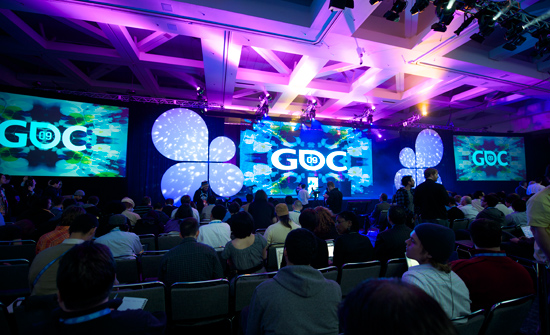
As with all conferences, this one started with a keynote. And not just any keynote. The 2009 Game Developers Conference started with a keynote from the president of Nintendo: Saturo Iwata.
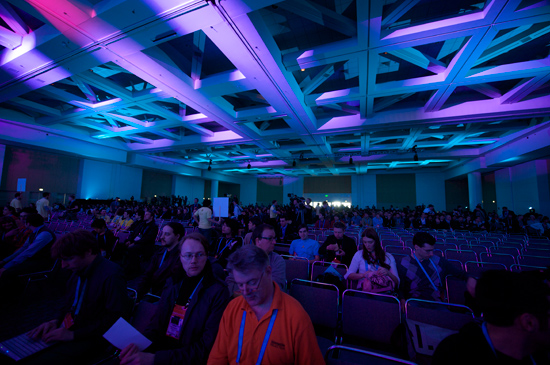
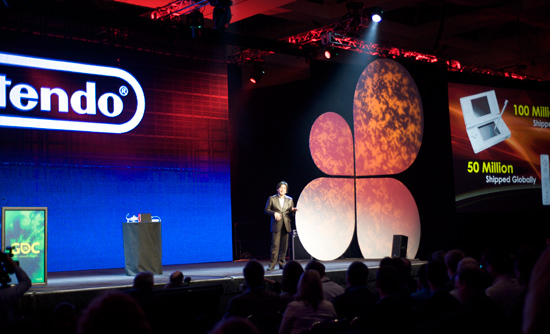
Iwata on stage
I’d never been to a Nintendo keynote before, nor had I ever heard Iwata speak. He spoke with a very mild lisp but was very calm, collected and confident in his delivery. I don’t really know how else to describe it other than that he spoke the way you’d expect the president of Nintendo to speak.
Nintendo has had a huge impact on the video game business in the US and around the world, largely due to the success of the Wii. The Wii is extremely popular, but Iwata really put it in perspective. Nintendo has shipped over 50 million Wii consoles since its launch in 2006. That’s the fastest ramp rate of any console. The Wii Balance Board, the peripheral that comes with Wii Fit, has sold around 15 million units. That in itself is nearly as many units shipped as Sony’s PlayStation 3.
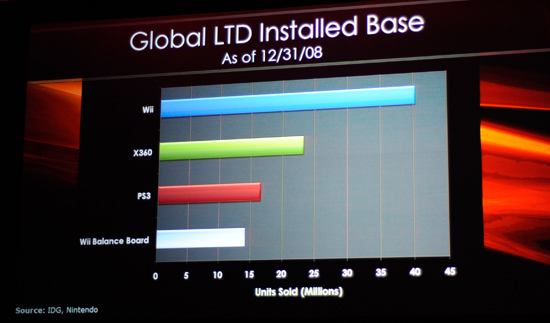
Over 40M consoles shipped by the end of last year. 50 million total since then.
The graph below shows total US video game market growth for an eight year period starting in 2001. The bars represent total video game hardware, software and accessory sales for each year in the US alone.
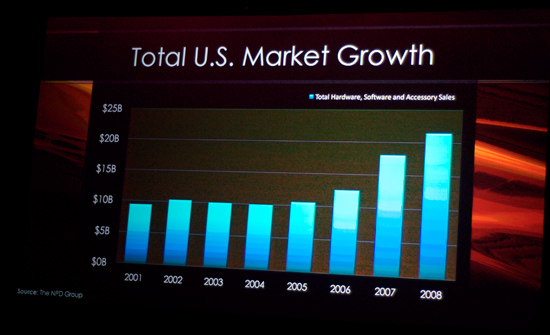
In 2008 the US video game industry broke $20B. That’s pretty impressive. Now look at what percentage of that growth was solely because of Nintendo:
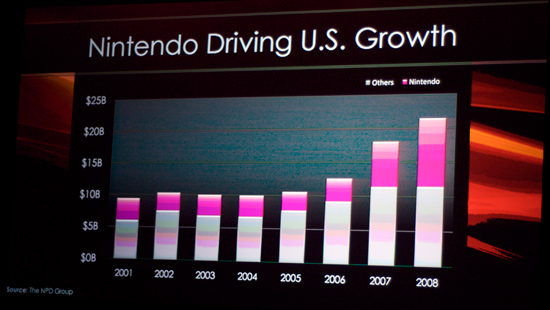
The pink sections of the bars are Nintendo related sales alone
Nintendo accounted for nearly $12B of the $22B US video game industry in 2008. There’s no other way to put it, Nintendo is single handedly driving growth in the US game industry - largely due to the Wii.
The trend is the same in the UK, Germany and France:
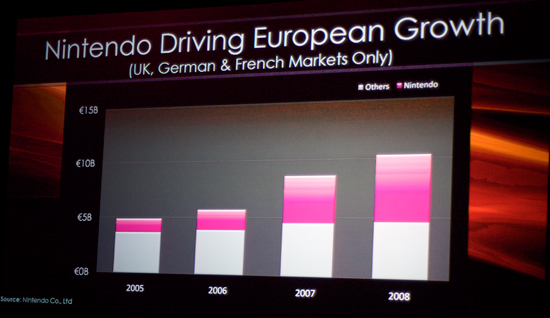
Around half of all video game related sales in those countries last year was because of Nintendo. The numbers are just ridiculous. Cute cuddly video game characters aside, Nintendo is as colossal of a market force as companies like Intel, Microsoft and Google in their respective industries. Nintendo’s size in itself shouldn’t be surprising, but when characterized in terms of the entire video game market it’s shocking.
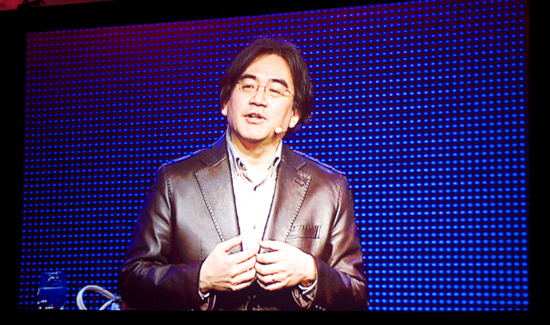
This next part was cool. Iwata took us through how goes about designing games. For those of you who don’t know, Miyamoto is the creator of Mario, Zelda, Pikmin, Nintendogs and some of Nintendo’s other extremely popular franchises. Given that Iwata was speaking to an audience of game developers, choosing to speak about Miyamoto’s approach to game design made a lot of sense. But to me, it was just awesome to hear about how someone who is great at his craft goes about his work. I love stories like that.
Let’s get started.
Miyamoto’s World
Miyamoto draws his inspiration from observation. He looks at other humans and watches how they interact, what they enjoy doing, etc... When he sees an activity that people enjoy he focuses on why they find that activity so entertaining. He thinks about things that most people just glaze over; most people know when they’re having fun, they don’t focus so much on why they’re having fun. He analyses himself and others in order to discover new ways to develop games that capture the fun people already know how to have. Miyamoto draws his inspiration from the life around him; he doesn’t sit down to make a game, he looks at what he and others enjoy in life and uses that to spark the innovation.
Iwata gave two examples; the first was when Miyamoto got a new garden, Pikmin shortly followed. And when Miyamoto got a new dog? Nintendogs came about.
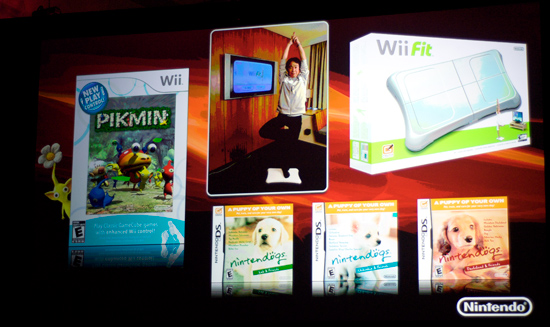
With the idea in mind, Miyamoto uses basic personal communication to start talking about it. He grabs a very small team and doesn’t do anything formal, they just talk. Miyamoto is all about personal communication, and that’s what happens here.
The next stage is to take this small team and begin prototyping the game. There’s no need for polish here, or anything other than the core concept of the game. As an example, this was the original prototype of Wii Boxing:
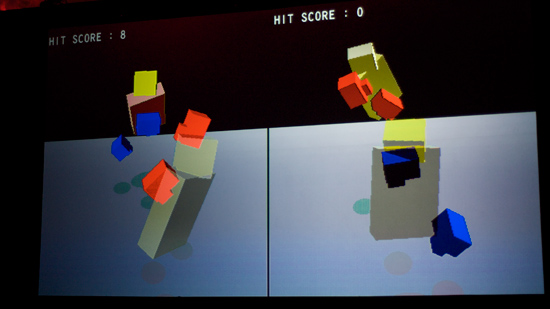
It’s not particularly attractive. There are no impressive shaders being used here. Miyamoto simply wants to test the basic mechanics of the game to see if it’ll be fun. The prototype stage is only concerned with the simple idea itself; don't worry about extraneous details - just core gameplay.
These small prototyping teams are sometimes only one developer large. There are often multiple projects in the prototype stage at the same time. This prototype stage can sometimes last as long as two years; not every concept ever makes it out of this stage, but Miyamoto never throws away the work that’s been done. While a prototype game or feature may not be used for the current project, it may come in handy somewhere down the line. Iwata said that he often times saw prototypes show up in games further down the line in ways you’d never expect.
It’s impossible to know what will be fun without trying it first. Miyamoto employs extensive use of trial and error in his prototyping stages, but that’s the beauty of not building fancy prototypes. If the concept doesn’t work, there’s not much extraneous work lost - it was simply a learning experience.
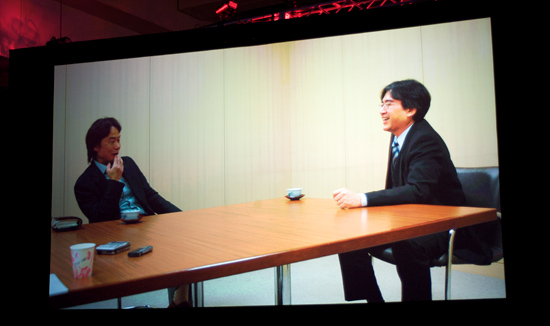
Miyamoto (left) and Iwata (right)
When a prototype succeeds, then and only then can the game get to a planning stage. This is where the documents come out and we start seeing some structure. With the core gameplay already defined, the next stage is mass production where the actual game is put together. The approach is very front loaded; if the core gameplay is done properly thanks to a well executed prototyping phase, building the rest of the game can go smoothly and according to schedule.
While the mass production stage is usually predictable, sometimes it does yield surprises. One of Miyamoto’s traits is that he never gets angry with his team when things don’t go according to plan. Mistakes are made and instead of a yell-fest, Miyamoto will even go as far as to personally help get things back on track. Iwata talked about it like someone turning a table upside down; Miyamoto helps pick up the pieces and put it back in order, rather than complain about the mess that was just made.
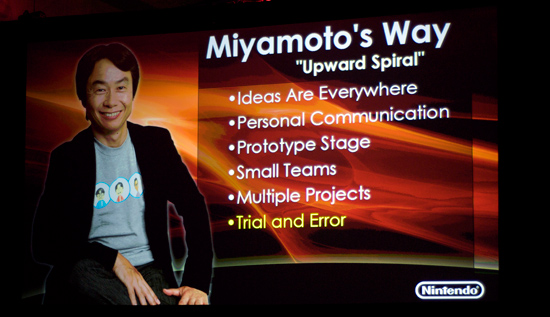
Because of Miyamoto’s aggressive focus on the prototyping stage, a game never needs to be restarted from scratch once it’s at the mass production phase. The prototype stage produced a well defined core concept. Sometimes ideas need to be dropped from the title because they don’t work out, but as I mentioned before, Miyamoto saves the ideas and can reuse them in later completely unrelated projects.
Iwata spoke of the “Death Spiral” in game development. Game developers face financial pressure to get games out on time; the developers rely on game sales to fund both current and future projects, so without that revenue stream there’s no hope for game development to continue. The financial pressure leads to less time to work on and perfect a game, which then leads to poor quality and poor sales. The spiral continues downwards until the developer can no longer remain competitive in the industry.
Iwata himself saw this death spiral first hand, as his previous job as a developer left him with 2 days to ship a title that needed months worth of work. Iwata sacrificed the quality due to sales pressure and eventually had to help restructure his company (HAL Laboratory) for bankruptcy. A much younger Iwata blamed finances alone for his employer’s failure as a game developer, but today Iwata believes that it has just as much to do with talent and approach to game development. His change in perspective is thanks to one man in particular: Shigeru Miyamoto.
According to Iwata, it’s Miyamoto’s methodical yet youthful approach to game development that gives him, and thus Nintendo, the edge. Iwata’s goal was to share one of Nintendo’s secrets success with the game developers in the audience. I just liked knowing how someone as significant as Miyamoto goes about his job.
The Two Most Hilarious Miyamoto Pictures
Before I get off the Miyamoto topic entirely I want to share two things that transpired during the keynote. First, Nintendo’s president talked about how Miyamoto engages in random employee kidnapping. He grabs an employee at random from the halls of Nintendo and makes him/her play one of these games in production. The employee doesn’t give any feedback; there are no forms or anything else formal, he/she just has to play the game and have fun - if that’s possible. It’s a very back-to-basics approach to game development that I believe is sometimes lost among everything that a developer needs to worry about.
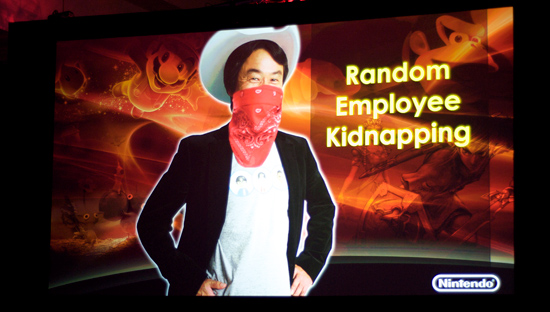
Awesome?
How does Miyamoto get feedback on the user’s experience with the game? Well he uses a over-the-shoulder approach to watching the user of course:
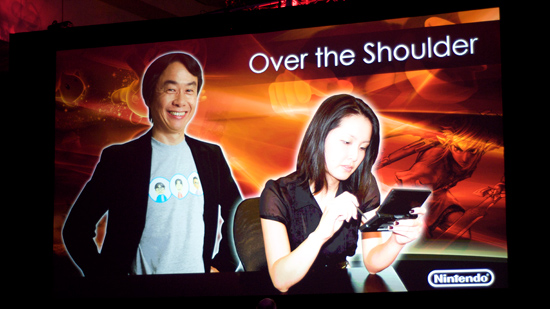
He made Mario
Yep.
Wii System Menu 4.0
While I don’t want my first article about GDC to be a complete Nintendofest, it’s worth talking about some of the improvements that Nintendo announced at the show. There were no major game releases and no real hardware improvements, just minor evolutionary enhancements to the Wii’s OS.
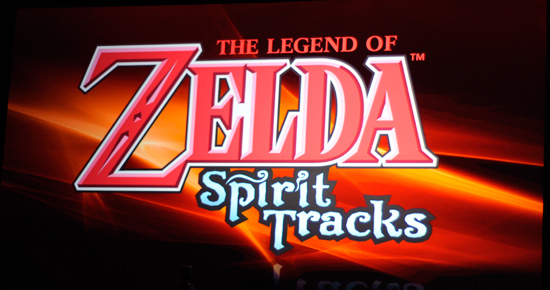
We did get word of a new Zelda title for the DS in 2009
The Wii System Menu 4.0 adds support for SD-HC cards (2GB - 32GB in size) - thus allowing you to store more game data on a single SD card in your Wii. You can also store entire WiiWare games (downloadable Wii titles) on your SD card. Previously you could only store downloadable games and content on the Wii’s internal flash, which is only 512MB in size.
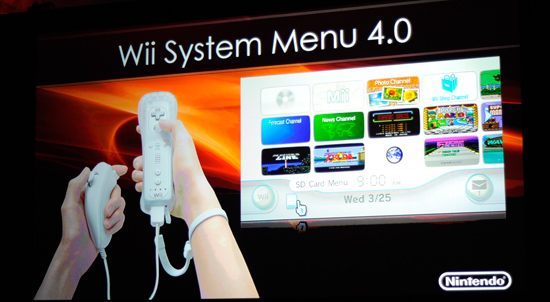
You can launch games directly from the SD card now too, and the system update is available today.
Third Party Development Doesn’t Suck on the Wii, I Swear!
Despite his comforting demeanor, Iwata’s keynote was a bit self serving. He very much wanted to convey the message that the Wii is good for 3rd party game developers, and that it’s not simply a cash cow for Nintendo.
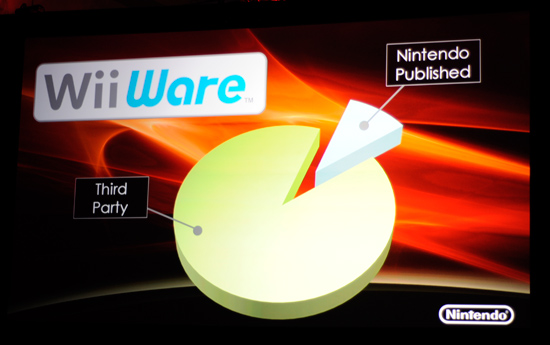
Look! The majority of WiiWare games are 3rd party titles.
That’s what the whole spiel about the Wii having such a large installed user base was designed to do. Iwata said that Nintendo had to work hard to build such a large user base and that now 3rd party developers can benefit from so many existing Wii systems in the market.
The reality of the matter is that installed user base doesn’t necessarily translate into very high game sales numbers, especially if you’re not Nintendo. There are tons of problems and lots of blame to pass around when it comes to developing on the Wii. It’s difficult to compete with Nintendo and the Wii doesn’t have powerful enough hardware to just port your Xbox 360/PS3 games over. On the flip side, there are more Wii consoles in the market than Xbox 360s or PS3s so it makes sense to put in some extra effort into making a Wii-specific game.
Nintendo says that 3rd party developers can succeed on the Wii. Some developers disagree. I figure the reality of the situation is somewhere in between there.
OnLive: Gaming Without the Hardware Requirements
I first read about OnLive before I ever set foot on the GDC show floor thanks to Dean Takahashi’s story on the service. If you haven’t read about it, here’s what it does.
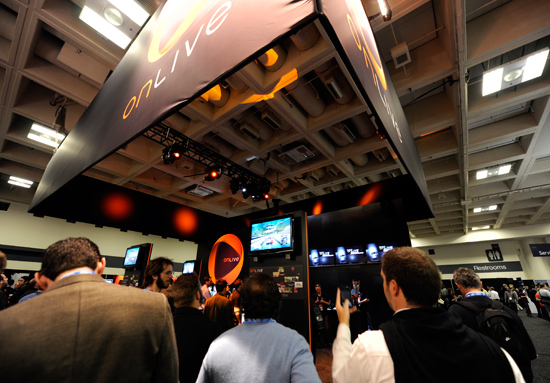
Today when you go to play a 3D game like BioShock or Unreal Tournament III, the rendering is done on your PC or console. There’s a reasonably powerful GPU and a fast CPU in your machine and it goes about calculating the color of every pixel on your screen and the impact of every explosion. The more demanding the game, the more powerful your CPU and GPU have to be.
Instead of doing that rendering locally in your home on your PC or console, OnLive seeks to do it remotely on powerful high end servers and simply stream the rendered frames to you, compressed, over the Internet.
OnLive claims that its compression technology is good enough to deliver HD resolution gaming over a standard Internet connection, without the need for a high speed PC or console. The bandwidth requirements are about 1Mbps for a 640 x 480 resolution and 5Mbps for 1280 x 720. The data compression algorithms are adaptive, so if you have poor network conditions the quality of the video sent to your screen will go down to compensate.
The benefit of OnLive is that you can play any title on any platform. OnLive will be supported on PCs, Macs and directly connected to a TV using a very light hardware client. There’s no word on pricing yet.
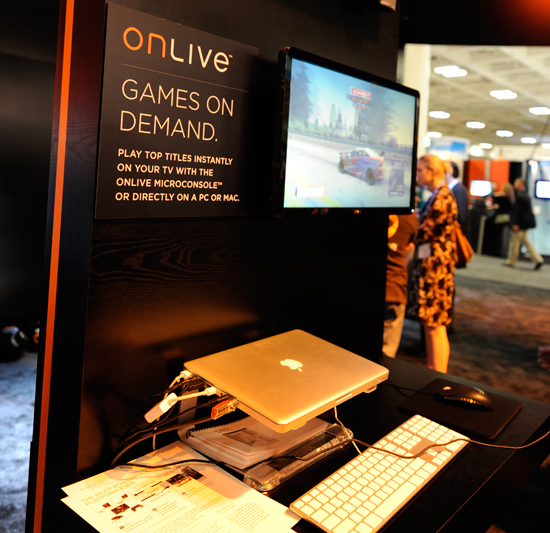
OnLive running on a MacBook
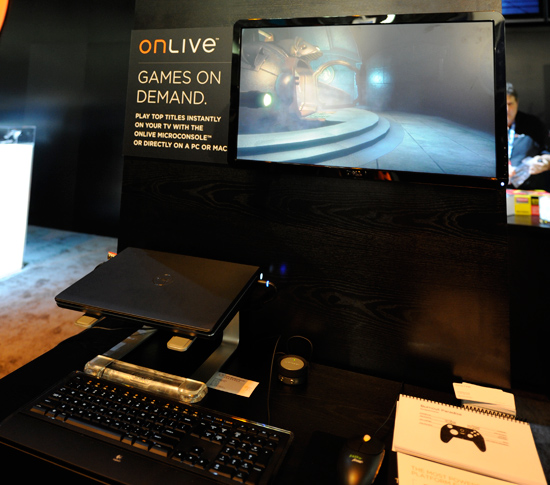
...and on a Dell notebook
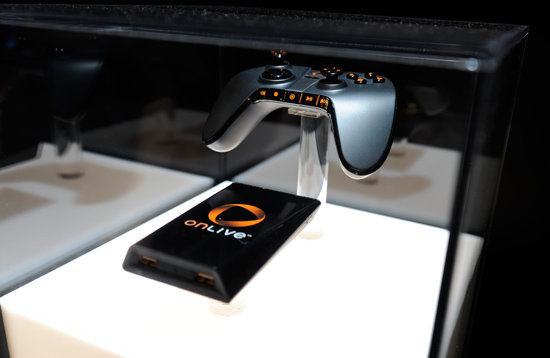
...or on the OnLive "console" hardware; basically a video encoder, ethernet and a USB port.
OnLive does have major game developer support. The list of developers includes the big names: EA, Ubisoft and Epic.
I played BioShock at OnLive’s booth. The game was streamed to me over the Internet and for the most part, it looked and felt like BioShock. The game didn’t look as good as running on a PC with a high end graphics card, and it felt like there was some sort of frame rate smoothing going on, but the technology worked.
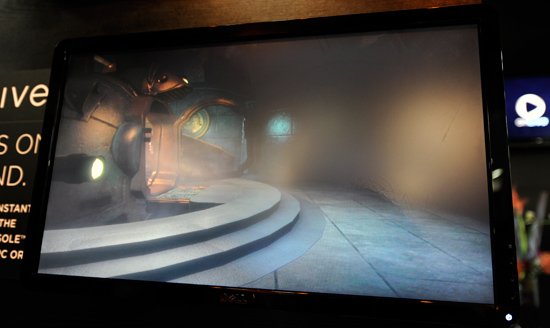
BioShock over the Internet. Cool.
The implications are huge. You wouldn’t need a high end PC or console to play the latest games. Game prices could be cheaper thanks to cutting out publisher and retail store overhead. Cross-platform multiplayer gaming would now be possible; if BioShock were a multiplayer game, you wouldn’t have to worry about which version was being played - you could play on your Mac with your friend on his/her PC.
OnLive is supposed to launch by the end of 2009.
Bigfoot is Back: Killer Xeno NIC
You all remember Bigfoot Networks, right? The makers of the Killer NIC? They’re back with a cheaper, updated product: the Killer Xeno.
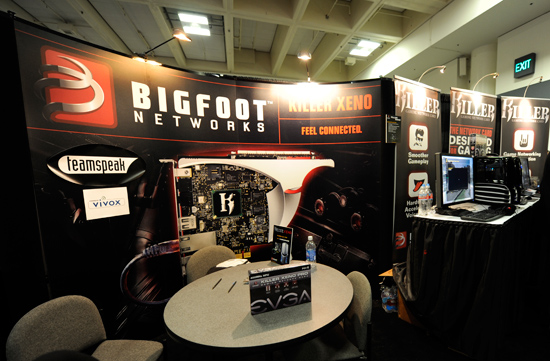
The Killer Xeno is a network card with an on-board processor, memory and lightweight Linux OS. It serves as a packet accelerator and voice/UDP offload processor for your PC. The idea is that the Windows audio and networking stacks are horribly inefficient and optimized for file transfers, not low latency gaming. The Killer Xeno bypasses the Windows audio/networking stacks and uses its own lightweight stacks to handle all voice chat/networking requests, theoretically translating into lower pings while gaming with voice chat enabled.
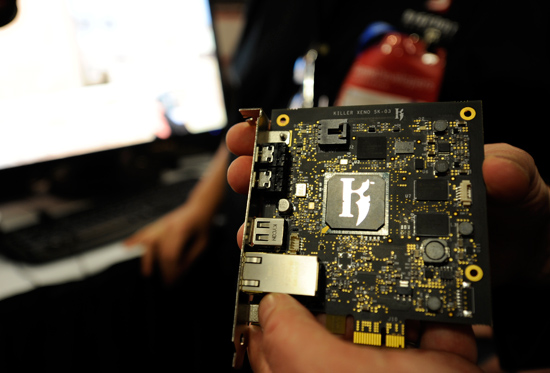
The new Killer NIC adds support for voice chat, a feature the original didn't have
We’ll be looking at the Killer Xeno in the not too distant future. Despite there being demos at the booth, none of them were the necessary Killer Xeno vs. No Killer Xeno tests to determine the usefulness of such a thing. We’ll put the card through its paces soon enough.
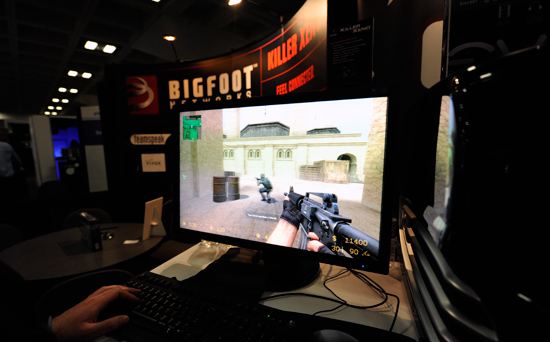
Counterstrike was the test of choice. Unfortunately there was no reference point for the demo.
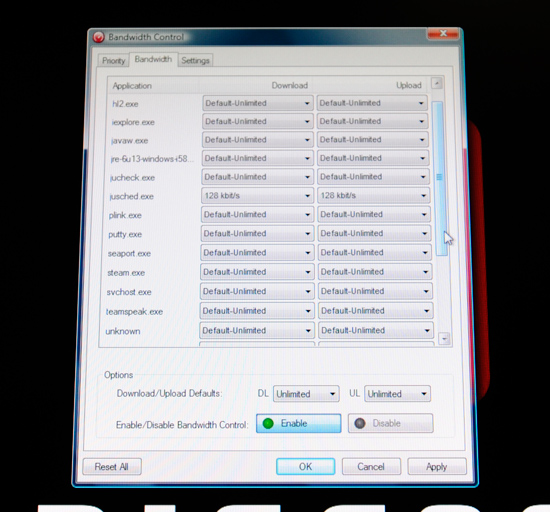
The Killer Xeno software includes an application that will let you throttle bandwidth to running processes/applications. The utility can also serve as an automatic alert/defender against undesired outbound or incoming network connections.
The Xeno will ship next month starting at $130.







